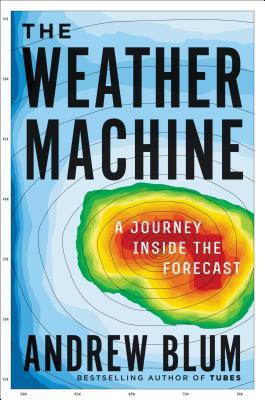
The Weather Machine
A Journey Inside the Forecast
کتاب های مرتبط
- اطلاعات
- نقد و بررسی
- دیدگاه کاربران
نقد و بررسی

February 1, 2019
As he did with his big hit Tubes: A Journey to the Center of the Internet, Blum investigates something crucial to our lives: the weather--and, more pointedly, how it is forecast. With a 50,000-copy first printing.
Copyright 2019 Library Journal, LLC Used with permission.

April 15, 2019
Journalist Blum (Tubes: A Journey to the Center of the Internet, 2012) takes a bright look at weather forecasting. The world's "weather machine" comprises a "global infrastructure of observation and prediction" peopled by hidden atmospheric scientists, data theorists, and others. Thanks to computer models, today's "weather men" deliver a six-day forecast that is "as good as a two-day forecast in the 1970s." Based on many interviews, this revealing, nicely crafted book guides us gently into a daunting subject through stories of unexpected people and events. The telegraph, introduced by Samuel Morse in 1844, first allowed us to know the weather in many places at one time. Ten years later, the Smithsonian began posting weather observations on a giant U.S. map in the lobby of its new Washington, D.C., headquarters. Norwegian meteorologist Vilhelm Bjerknes (1862-1951) used math and physics to analyze the atmospheric variables (density, humidity, temperature, etc.) of a single moment and extrapolate a weather forecast. Many more observations were needed for the method to work with accuracy, and much of Blum's book recounts how laboratories, lighthouses, farmers, and others, including today's weather satellites, formed a worldwide system of collecting data that is now fed into weather models to become sophisticated forecasts. Today, thousands of weather stations are networked through the U.N.'s World Meteorological Organization. Blum's travels offer glimpses of the National Center for Atmospheric Research's Mesa Lab in Colorado and the "Euro" forecast factory in Reading, England; meteorology conventions where small instrument makers exhibit next to Raytheon, Northrop Grumman, and other manufacturers of drones and satellites; the ongoing $11 billion makeover of the U.S. satellite program; and the Weather Company, which provides forecasts for TV and websites worldwide. A "last bastion of international cooperation," the current system of data exchange may one day be supplanted by global corporations, writes the author. A solid popular account with plenty of quirky detail about this "new way of seeing into the future."
COPYRIGHT(2019) Kirkus Reviews, ALL RIGHTS RESERVED.

June 10, 2019
Meteorology is “a wonder we treat as a banality,” argues journalist Blum (Tubes: A Journey to the Center of the Internet) in his deep dive into the field’s evolution. While humanity had long struggled to predict weather with some degree of accuracy, it wasn’t possible until the telegraph’s mid-19th-century arrival. The ability to recognize and share timely information led to a better understanding of weather patterns, first on a continent-wide and eventually on a global scale. This, along with a few happy accidents and some really tough math, led to the development and refinement of the systems which people know and complain about today. Excursions to forecasting labs and weather stations around the world, along with interviews with behind-the-scenes scientists, fill in the blanks, while asides on the political ramifications of weather satellites and global forecasting and on Thomas Jefferson’s early forays into forecasting add depth and intrigue. Thanks to Blum’s immersive research, readers will come away with a greater appreciation for the hard work that goes into something often taken for granted.

May 15, 2019
Many of us check the weather forecast on a daily basis, but the human effort and ingenuity that goes into each forecast often remains a mystery. Journalist Blum (Tubes, 2012) breaks down the near-unimaginable complexity of the weather forecasting system into its component parts. Beginning with the advent of the telegraph, which made it possible to communicate local weather conditions to distant points on the globe, weather forecasting has been a locus of innovation and international cooperation. Blum reveals the inner workings of the many cogs in the forecasting machine, from a NASA satellite intended to measure soil moisture from space, to a Norwegian observation station that has operated continuously since the 1860s, to a congress of the UN's World Meteorological Organization. Though readers may occasionally get lost in a sea of acronyms, Blum most often manages to draw clear lines between theory and practice. This is a lucid and approachable guide to the satellites, scientists, and supercomputers that make up the forecasting system we so often take for granted.(Reprinted with permission of Booklist, copyright 2019, American Library Association.)

























دیدگاه کاربران